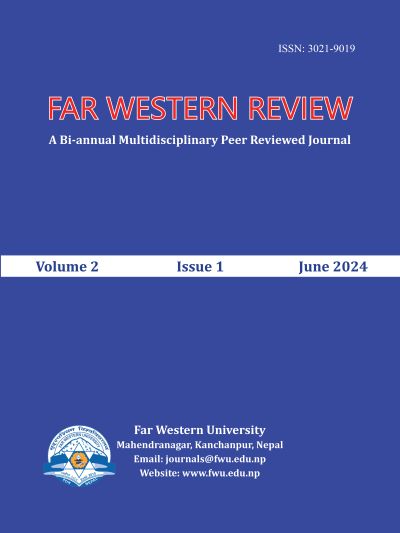Economic Assessment of Tuta Absoluta Effect on Tomato Production in East Nawalparasi
DOI:
https://doi.org/10.3126/fwr.v2i1.70544Keywords:
BC ratio, gross return, pest management, production, varietiesAbstract
Tuta absoluta is an invasive and highly destructive pest of tomato plants, originated in South America, specifically Peru. It has the capability to infest and cause extensive damage to large areas of cultivated tomato fields, as well as other plants in the solanaceous family. This study aims to assess the economic analysis of effect of Tuta absoluta on tomato production. The study was carried out in Kawasoti municipality, Madhyabindu municipality, and Hupsekot rural municipality of East Nawalparasi district of Nepal. They were selected purposively as research sites as the problem of Tuta was more prominent in these localities. Ninety households that were involved in tomato cultivation were selected through the simple random sampling method for the survey. The primary data were collected through individual respondents through pre-tested questionnaires, face-to-face questionnaire surveys, key informant interviews, and focus group discussions. Descriptive statistics, scaling & indexing were used to analyze the data. Most of the farmers cultivated tomatoes in open fields (68.8%) only whereas 26.6% of farmers cultivated in plastic tunnels. The insect pest problem was ranked as the first major problem of farmers. The study revealed that all of the farmers had problems with Tuta in their tomato fields. The minimum yield loss due to Tuta absoluta was 10% and the maximum loss was 80%. The total variable cost (T.V.C) for tomato production in one kathha is NRs. 11210. Average production of tomato per kathha was 550 kg. Gross return and gross margin from tomato cultivation in 1 kathhaare NRs. 16500 with Benefit Cost Ratio (BCR) of 1.64. The average loss of tomatoes per kathha was 72 kg. Only 20 % of the farmers had knowledge regarding the life cycle Tuta absoluta. The most affected stage by Tuta was the flowering stage. This study suggests that effective management of Tuta absoluta can substantially improve tomato production.
Downloads
Downloads
Published
How to Cite
Issue
Section
License

This work is licensed under a Creative Commons Attribution-NonCommercial 4.0 International License.
CC BY-NC: This license allows reusers to distribute, remix, adapt, and build upon the material in any medium or format for noncommercial purposes only, and only so long as attribution is given to the creator.




